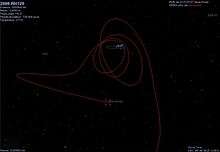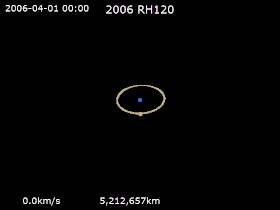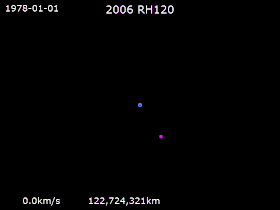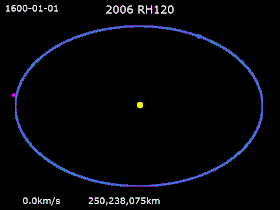2006 RH120
2006 RH120 is a tiny near-Earth asteroid[4] and fast rotator with a diameter of approximately 2–3 meters[5] that ordinarily orbits the Sun but makes close approaches to the Earth–Moon system around every twenty years,[7] when it can temporarily enter Earth orbit through temporary satellite capture (TSC). Most recently, it was in Earth orbit from September 2006 to June 2007.[8] As a consequence of its temporary orbit around the Earth, it is currently the smallest asteroid in the Solar System with a well-known orbit.
| Discovery[1] | |
|---|---|
| Discovered by | Catalina Sky Survey (Eric Christensen) |
| Discovery date | 14 September 2006 |
| Designations | |
| 2006 RH120 | |
| Orbital characteristics[2] | |
| Epoch 31 July 2016 (JD 2457600.5) | |
| Uncertainty parameter 1 | |
| Observation arc | 281 days |
| Aphelion | 1.058 AU (158.3 Gm) (Q) |
| Perihelion | 1.0078 AU (150.76 Gm) (q) |
| 1.0331 AU (154.55 Gm) (a) | |
| Eccentricity | 0.02448 (e) (Geocentric hyperbolic e=2300000+)[lower-alpha 1] |
| 1.05 yr | |
| 95.200° (M) | |
| Inclination | 0.59505° (i) |
| 51.166° (Ω) | |
| 10.045° (ω) | |
| Earth MOID | 0.01627 AU (2,434,000 km) |
| Jupiter MOID | 3.93 AU (588 Gm) |
| Physical characteristics | |
| Dimensions | ~2–3 m[5] |
| 0.1 ? | |
| 29.5[4] | |
Until given a minor planet designation on 18 February 2008,[1] the object was known as 6R10DB9, an internal identification number assigned by the Catalina Sky Survey.[6]
Discovery
2006 RH120 was discovered on 14 September 2006 by Eric Christensen with the 27-inch (690 mm) Schmidt camera of the Catalina Sky Survey in Arizona.[9] "6R10DB9"[9] was the Catalina Sky Survey's own discovery designation for this object, which usually would only be used on the MPC's NEO Confirmation Page (NEOCP) until an IAU designation was applied, if the object was classified as a minor object. It was added on 14 September to the NEOCP and subsequently removed with the explanation that it "was not a minor planet".[10] Preliminary orbital calculations indicated it was captured by Earth's gravity from solar orbit of a period of about 11 months, which is similar to that of many spent rocket boosters dating to the Apollo program of the 1960s and early 1970s. 6R10DB was assigned the designation 2006 RH120 on 18 February 2008.[1]
Origin
Some controversy existed regarding the origin of the object. Upon discovery, it was not given a formal name because its spectrum was consistent with the white titanium-oxide paint used on Saturn V rockets,[11] which meant it could be an artificial object. Precedents for this exist: J002E3 is currently thought to be the third-stage Saturn S-IVB booster from Apollo 12 and was in an almost identical orbit,[12] and 6Q0B44E, discovered a month earlier, was also thought to be artificial.[13] Its status as a satellite was also debated, with A. W. Harris of the Space Science Institute commenting, "Claiming some bit of fluff in a temporary looping orbit to be a 'satellite', with all the baggage that term carries, is mere hype".[7][14]
Orbit
Analysis has shown that solar-radiation pressure is perturbing its motion perceptibly.[15] However, Paul Chodas in JPL's Solar System Dynamics Group suspects that the perturbations are consistent with expectations for a rocky object but not with old flight hardware.[15] One hypothesis is that the object is a piece of lunar rock ejected by an impact.[7] On 18 February 2008, the object was given a minor planet designation.[1]
The object made four Earth orbits of about three months each before being ejected after the June 2007 perigee. At that perigee, it dipped inside the Moon's orbit to a distance of 276,845 kilometres (172,024 mi).[6] 2006 RH120 became an Apollo-class asteroid in June 2007.




14 June 2007 perigee
On 14 June 2007, 2006 RH120 made its fourth and last perigee of the most recent Earth encounter.[16] It was 0.7 lunar distances at closest, with an apparent magnitude of 18.5–19.0. Astronomers at JPL Goldstone in California made radar astrometry measurements on 12, 14 and 17 June 2007.
Future events
2006 RH120 is now in solar orbit[14] as an Amor-class asteroid[2] with an orbit completely outside of Earth's orbit. As of 2017, this object is 2 AU from Earth on the other side of the Sun.[17] Systematic residuals in the positions of the object probably indicate that the model used to determine solar radiation pressure may be too simple to adequately describe its motion over a long period of time.[6] The next near-Earth encounter is in August 2028 when the object will pass Earth at a relatively low speed of 136 metres per second (304 miles per hour).[6][16] For comparison, on 13 April 2029, asteroid 99942 Apophis will pass Earth at a relative speed of 7.4 kilometres per second (17,000 miles per hour).[18] 2006 RH120 is listed as part of the Near-Earth Object Human Space Flight Accessible Targets Study (NHATS).[19]
See also
- 1991 VG – temporary Earth satellite discovered in 1991
- 2020 CD3 – another temporary Earth satellite discovered in 2020
- 6Q0B44E – small Earth satellite, probably artificial
- 3753 Cruithne – horseshoe companion of the Earth
- 2002 AA29 – horseshoe companion of the Earth
- (419624) 2010 SO16 – horseshoe companion of the Earth
- Natural satellite
- Claimed moons of Earth
- Quasi-satellite
- Space debris
Notes
- Computed with JPL Horizons using a geocentric solution. Ephemeris Type: Orbital Elements / Center: 500 / Time Span: 2016-07-31 (to match infobox epoch)
References
- Williams, Gareth V (18 February 2008). "MPEC 2008-D12 : 2006 RH120". IAU Minor Planet Center. Harvard–Smithsonian Center for Astrophysics. Archived from the original on 9 April 2010. Retrieved 26 February 2010.
- "2006 RH120 Orbit". Minor Planet Center. Archived from the original on 25 February 2014. Retrieved 7 February 2017.
- archive.is: Epoch 2012 = Apollo
- "JPL Small-Body Database Browser: (2006 RH120)" (last observation: 2007-06-22; arc: 281 days). Retrieved 30 March 2016. (Epoch 2007 solution)
- Brent W. Barbee. "Accessible Near-Earth Objects (NEOs)" (PDF). 12th Meeting of the Small Bodies Assessment Group (SBAG) 2015. Retrieved 12 January 2015. (pg 17 for diameter)
- Great Shefford Observatory. "2006 RH120 ( = 6R10DB9) – A second moon for the Earth?". Archived from the original on 9 May 2008. Retrieved 16 April 2008.
- Bill Gray. ""Pseudo-MPEC" for 6R10DB9". Archived from the original on 27 September 2007. Retrieved 16 August 2007.
- "Mystery Mini Moons: How Many Does Earth Have?". DNews.
- "Distant Artificial Satellites Observation (DASO) Circular No. 68, 2006 Sept. 17, 16:59 UT". Retrieved 26 June 2007.
- "Major News About Minor Objects, April 18, 2007". Retrieved 27 June 2007.
- Spectrum measured by Carl Hergenrother and Rob Whitely of the University of Arizona.
- Yeomans, Don (April 2010). "Is Another Moon Possible?". Astronomy.
- The Guardian, Spacewatch, 6 September 2006
- Roger W. Sinnott (17 April 2007). "Earth's "Other Moon"". Sky & Telescope. Archived from the original on 27 August 2012. Retrieved 25 February 2010.
- Dr. Lance A. M. Benner (20 June 2007). "6R10DB9 Planning". JPL/NASA Asteroid Radar Research. Retrieved 27 February 2010.
- "JPL Close-Approach Data: (2006 RH120)" (last observation: 2007-06-22; arc: 281 days). Retrieved 27 February 2010.
- "2006RH120 Ephemerides for 2007 to 2028". NEODyS (Near Earth Objects – Dynamic Site). Retrieved 24 February 2015.
- "JPL Close-Approach Data: 99942 Apophis (2004 MN4)". Retrieved 15 February 2015.
- "NHATS Object/Trajectory Details: (2006 RH120)". Retrieved 24 February 2015.
External links
- Great Shefford Observatory's 6R10DB9 images and background
- Earth's "Other Moon" on SkyandTelescope.com
- JPL Radar Astrometry Page
- Bill Gray's Pseudo-MPEC Page on 6R10DB9
- Photometry of 2006 RH120: an asteroid temporarily captured into a geocentric orbit (Astronomy & Astrophysics 2009)
- Interactive 3D visualisation of the Earth 2006 RH120 capture event
- 2006 RH120 at the JPL Small-Body Database